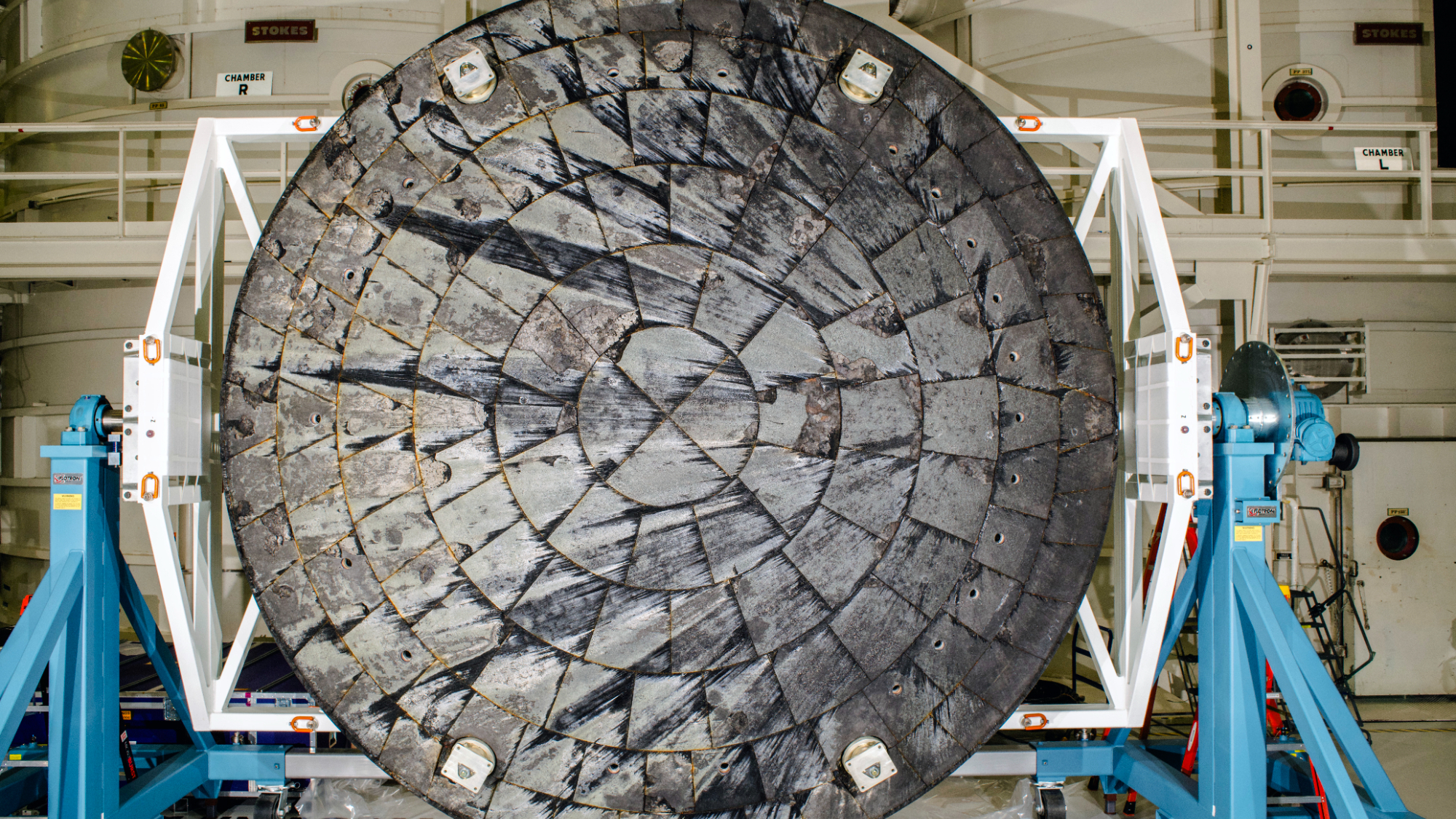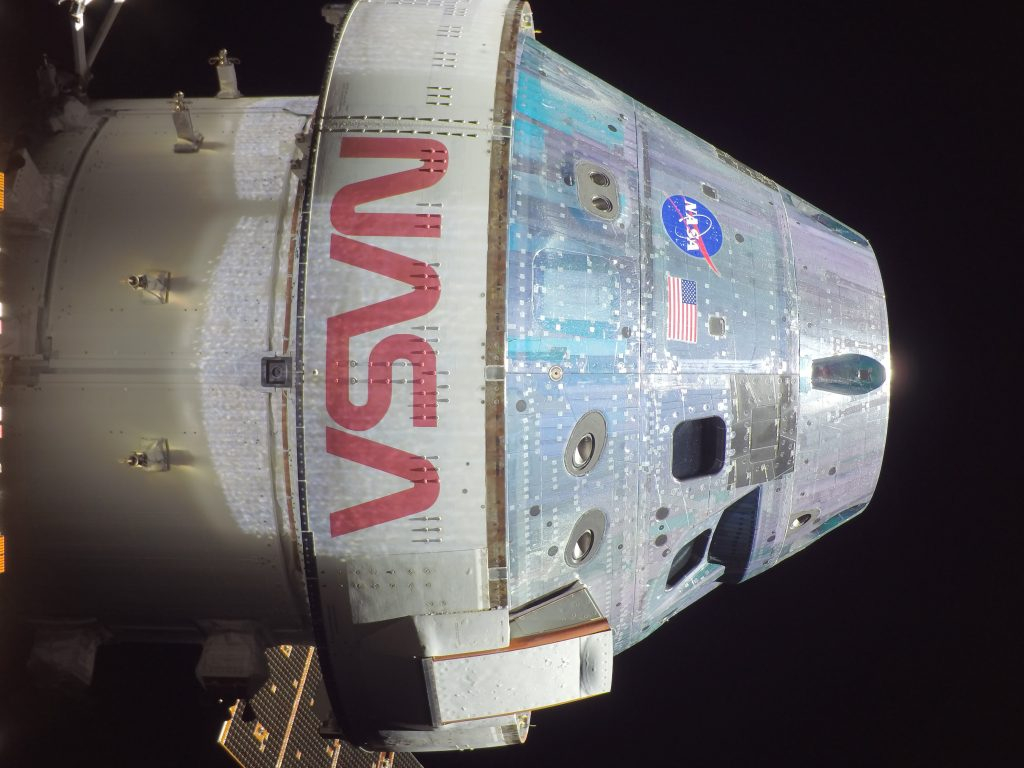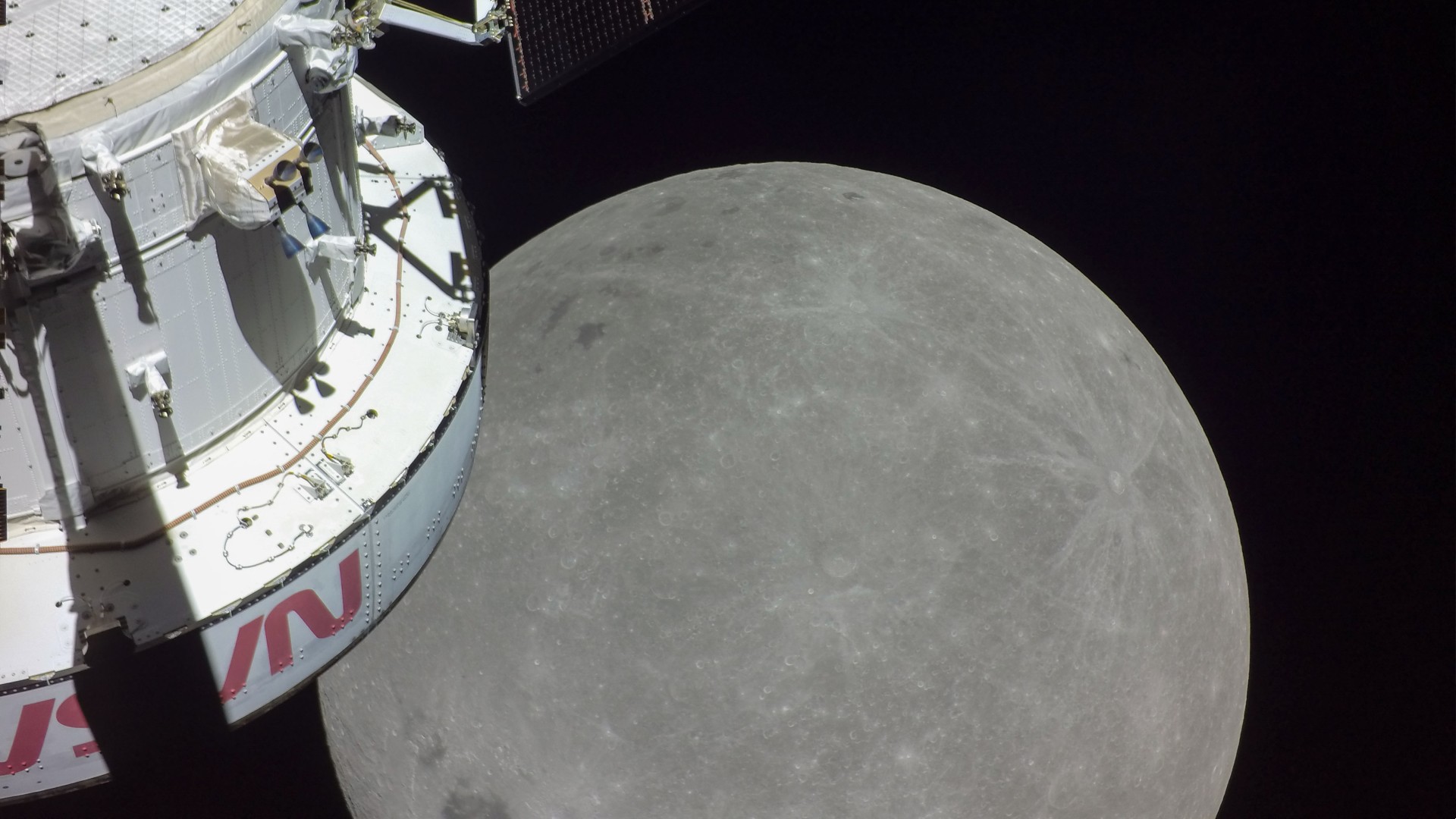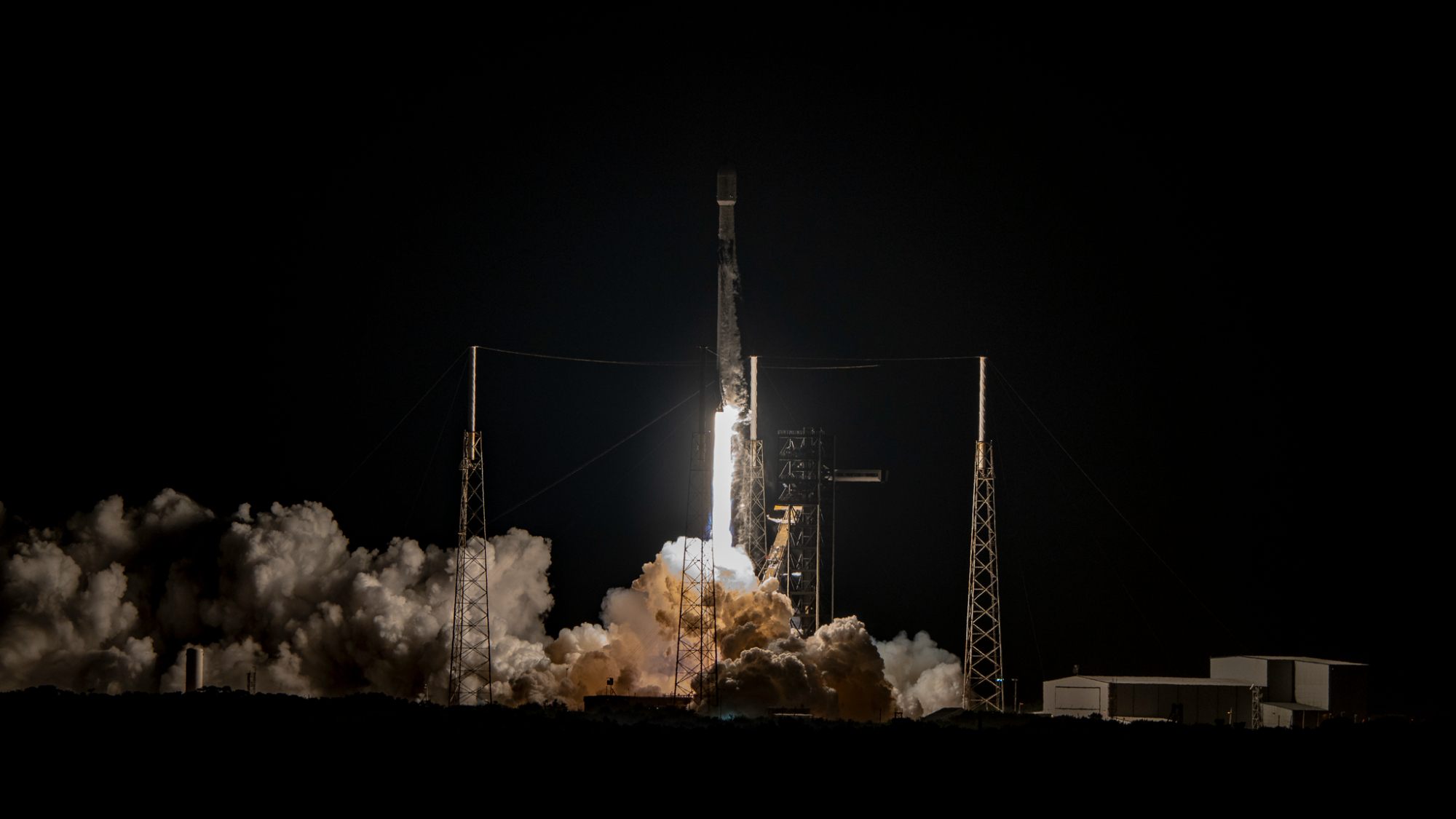
NASA's Orion crew capsule had heat shield issues during Artemis 1 − an aerospace expert weighs in (op-ed)
Issues with the Orion spacecraft's heat shield on Artemis 1 have delayed the next mission, Artemis 2. So what happened?

This article was originally published at The Conversation. The publication contributed the article to Space.com's Expert Voices: Op-Ed & Insights. Marcos Fernandexz Tous is a professor of aerospace technology at the University of North Dakota.
Off the coast of Baja California in December 2022, sun sparkled over the rippling sea as waves sloshed around the USS Portland dock ship. Navy officials on the deck scrutinized the sky in search of a sign. The glow appeared suddenly.
A tiny spot at first, it gradually grew to a round circle falling at a great speed from the fringes of space. It was NASA’s Orion capsule, which would soon end the 25-day Artemis I mission around and beyond the moon with a fiery splashdown into the ocean.
Orion's reentry followed a sharply angled trajectory, during which the capsule fell at an incredible speed before deploying three red and white parachutes. As the mission finished its trip of over 270,000 miles (435,000 kilometers), it looked to those on the deck of the USS Portland like the capsule had made it home in a single piece.
As the recovery crew lifted Orion to the carrier's deck, shock waves ruffled across the capsule’s surface. That’s when crew members started to spot big cracks on Orion’s lower surface, where the capsule’s exterior bonds to its heat shield.
But why wouldn’t a shield that has endured temperatures of about 5,000 degrees Fahrenheit (2,760 degrees Celsius) sustain damage? Seems only natural, right?
This mission, Artemis I, was uncrewed. But NASA's ultimate objective is to send humans to the moon in 2026. (The target is now 2027.) So, NASA needed to make sure that any damage to the capsule– even its heat shield, which is meant to take some damage – wouldn’t risk the lives of a future crew.
Get the Space.com Newsletter
Breaking space news, the latest updates on rocket launches, skywatching events and more!
On Dec. 11, 2022 – the time of the Artemis I reentry – this shield took severe damage, which delayed the next two Artemis missions. While engineers are now working to prevent the same issues from happening again, the new launch date targets April 2026, and it is coming up fast.
As a professor of aerospace technology, I enjoy researching how objects interact with the atmosphere. Artemis I offers one particularly interesting case – and an argument for why having a functional heat shield is critical to a space exploration mission.

Taking the heat
To understand what exactly happened to Orion, let’s rewind the story. As the capsule reentered Earth’s atmosphere, it started skimming its higher layers, which acts a bit like a trampoline and absorbs part of the approaching spacecraft’s kinetic energy. This maneuver was carefully designed to gradually decrease Orion's velocity and reduce the heat stress on the inner layers of the shield.
After the first dive, Orion bounced back into space in a calculated maneuver, losing some of its energy before diving again. This second dive would take it to lower layers with denser air as it neared the ocean, decreasing its velocity even more.
While falling, the drag from the force of the air particles against the capsule helped reduced its velocity from about 27,000 miles per hour (43,000 kilometers per hour) down to about 20 mph (32 kph). But this slowdown came at a cost – the friction of the air was so great that temperatures on the bottom surface of the capsule facing the airflow reached 5,000 degrees Fahrenheit (2,760 degrees Celsius).
At these scorching temperatures, the air molecules started splitting and a hot blend of charged particles, called plasma, formed. This plasma radiated energy, which you could see as red and yellow inflamed air surrounding the front of the vehicle, wrapping around it backward in the shape of a candle.
No material on Earth can stand this hellish environment without being seriously damaged. So, the engineers behind these capsules designed a layer of material called a heat shield to be sacrificed through melting and evaporation, thus saving the compartment that would eventually house astronauts.
By protecting anyone who might one day be inside the capsule, the heat shield is a critical component.
In the form of a shell, it is this shield that encapsulates the wide end of the spacecraft, facing the incoming airflow – the hottest part of the vehicle. It is made of a material that is designed to evaporate and absorb the energy produced by the friction of the air against the vehicle.
The case of Orion
But what really happened with Orion’s heat shield during that 2022 descent?
In the case of Orion, the heat shield material is a composite of a resin called Novolac – a relative to the Bakelite which some firearms are made of – absorbed in a honeycomb structure of fiberglass threads.

As the surface is exposed to the heat and airflow, the resin melts and recedes, exposing the fiberglass. The fiberglass reacts with the surrounding hot air, producing a black structure called char. This char then acts as a second heat barrier.
NASA used the same heat shield design for Orion as the Apollo capsule. But during the Apollo missions, the char structure didn’t break like it did on Orion.
After nearly two years spent analyzing samples of the charred material, NASA concluded that the Orion project team had overestimated the heat flow as the craft skimmed the atmosphere upon reentry.
As Orion approached the upper layers of the atmosphere, the shield started melting and produced gases that may have escaped through pores in the material. Then, when the capsule gained altitude again, the outer layers of the resin froze, trapping the heat from the first dive inside. This heat vaporized the resin.
When the capsule dipped into the atmosphere the second time, the gas expanded before finding a way out as it heated again – kind of like how a frozen lake thaws upward from the bottom – and its escape produced cracks in the capsule’s surface where the char structure got damaged. These were the cracks the recovery crew saw on the capsule after it splashed down.
In a Dec. 5, 2024, press conference, NASA officials announced that the Artemis II mission will be designed with a modified reentry trajectory to prevent heat from accumulating.
For Artemis III, which is planned to launch in 2027, NASA intends to use new manufacturing methods for the shield, making it more permeable. The outside of the capsule will still get very hot during reentry, and the heat shield will still evaporate. But these new methods will help keep the astronauts cozy in the capsule all the way through splashdown.
Chonglin Zhang, assistant professor of mechanical engineering at the University of North Dakota, assisted in researching this article. Read the original article.
Join our Space Forums to keep talking space on the latest missions, night sky and more! And if you have a news tip, correction or comment, let us know at: community@space.com.

-
Unclear Engineer So, NASA is going to do an untested re-entry profile with humans aboard for Artemis II and then use an untested new manufacturing technique for the heat shield on the crewed Artemis III mission?! By untested, I mean not flight tested.Reply
That concerns me. Just like there were unexpected effects on the heat shield in Artemis I, there could be other unexpected effects for different reentry profiles and for new manufacturing techniques.
Considering the extreme costs of one or even two more SLS launches, I understand why NASA wants to take the risk instead of canceling the program.
But, I am wondering if there is a way to use StarShip or even Falcon Heavy to do an uncrewed flight test. It does not have to go to the Moon, it just needs to be brought into the atmosphere at the desired speed and angle. So, a lot of the delta-V would go into accelerating the capsule downward. -
George² Reply
Only for this type of flight test even ordinary Falcon 9 have enough power to send Orion. Because the ship doesn't need to be fully loaded with fuel and payload, as in an actual flight to the Moon.Unclear Engineer said:But, I am wondering if there is a way to use StarShip or even Falcon Heavy to do an uncrewed flight test. -
Unclear Engineer George, It is not just a matter of launching the Orion capsule into orbit. The test would need to accelerate the Orion capsule to much higher velocity and change its orbital parameters so that it looks like it is coming back from the Moon at about 25,000 mph, and on what would be a highly elliptical orbit (if the Earth was just a point of mass).Reply
I know that SpaceX was at one time planning to send one of its Dragon capsules around the Moon, But, that is a different mass. So, I am not sure it could be done with the Orion capsule with Falcon. But, I'm not sure it couldn't be done, either.
That is why I am asking the question. -
George² Reply
I think that is possible with all stages of Falcon 9 block 5 are used in expendable regime and let me remind you that Orion does not need to be loaded with maximum payload.Unclear Engineer said:George, It is not just a matter of launching the Orion capsule into orbit. The test would need to accelerate the Orion capsule to much higher velocity and change its orbital parameters so that it looks like it is coming back from the Moon at about 25,000 mph, and on what would be a highly elliptical orbit (if the Earth was just a point of mass).
I know that SpaceX was at one time planning to send one of its Dragon capsules around the Moon, But, that is a different mass. So, I am not sure it could be done with the Orion capsule with Falcon. But, I'm not sure it couldn't be done, either.
That is why I am asking the question. -
Unclear Engineer For a heat shield test, yes, Orion does need to be loaded to its maximum mass limit.Reply
The amount of energy that needs to be removed during atmospheric reentry is directly proportional to the mass of the reentering spacecraft. So, the temperatures and heating rates that the shield must endure are strongly influenced by the total mass of the craft. -
George² Reply
This is not realistic. Orion does indeed return at high speed, but significantly lightened in fuel and cargo. Furthermore, only the crew capsule lands.Unclear Engineer said:For a heat shield test, yes, Orion does need to be loaded to its maximum mass limit.
The amount of energy that needs to be removed during atmospheric reentry is directly proportional to the mass of the reentering spacecraft. So, the temperatures and heating rates that the shield must endure are strongly influenced by the total mass of the craft. -
Unclear Engineer Maybe we are talking past each other. For a proper test of the heat shield, the capsule needs to be at its maximum mass for reentry from any planned mission.Reply
But, for purposes of getting a Falcon 9 to be able to drive it into the atmosphere at a speed and angle that simulates a return from lunar missions, none of the parts that are not attached to the capsule during reentry from the Moon need to be launched and then accelerated towards the Earth for that test.
Yes, there may be some propellant of other expendables that would not be completely filling the tanks of the Orion capsule when it returns. But, most of that gets jettisoned with the service module and is not part of the reentry configuration.
A quick Googling indicates that the launch mass of the capsule is 10,400 kg, and the landing weight of the capsule is 9,300 kg + 100 kg of "payload", which I assume is going to be lunar rocks. Presumably, both the launch weight and reentry weight includes the astronauts and all of the gear they are wearing.
So, an upper stage of a launch vehicle for such a test would need to be able to accelerate about 9.400 kg, plus itself, to about 25,000 mph (45,000 kph) back toward the Earth from some peak altitude. It would not necessarily need to go into an orbit - it could be a mostly ballistic trajectory, with some sideways velocity added to achieve the correct angle for reentry. -
Classical Motion From what I read, a shield of man made diamond dust should protect any mass at velocity to enter safely. But one knows not what to believe.Reply -
Unclear Engineer Googllng a bit more, the Falcon 9 is rated for only 4,020 kg to Mars, which should be a roughly equivalent delta-V to an Orion reentry test mission.Reply
The Falcon Heavy is rated for 16,800 kg payload to Mars. So, I would think that a Falcon Heavy could be used to test the Orion heat shield for a lunar return reentry - provided the staging works out for getting the second stage to the right altitude and then restarting and accelerating itself and the capsule back toward Earth at a final velocity of 25,000 mph (40,000 kph).
But, somebody would need to look at what stages need to fire for what periods of time to make that happen, to see if the current equipment could be easily configured to do that mission.
If the ESM had to be included to get the right flight parameters, that would be a problem, because that weighs 15,461 kg, and that plus a 9, 400 kg capsule would total 24,851 kg, which is more than the Falcon Heavy could seem to be able to handle for that mission.
Still, if the Falcon Heavy cansend 16,800 kg to Mars, I would think it could send the Orion capsule around the Moon, if necessary to get the proper reentry. The only hangup I see is whether the accuracy of the reentry parameters could be achieved without the service module attached to the capsule during the return. Maybe some sort of mission specific trans stage would be needed. And that could be expensive and time consuming to develop. -
George² The Falcon 9 Mars payload delivery estimate is likely to include a reusable first stage not in fully expendable regime. It also likely includes a deceleration for orbit entry and possible engine-assisted landing. This requires more fuel and oxidizer to be retained for these operations. So the vehicle will have a higher mass than payload during the intermediate stages of the flight to Mars.Reply









